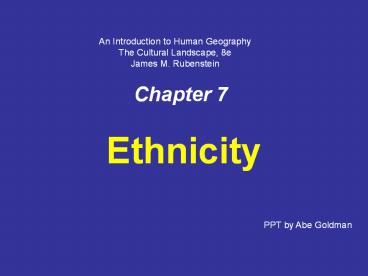Ethnicity - PowerPoint PPT Presentation
1 / 29
Title: Ethnicity
1
Chapter 7
An Introduction to Human Geography The Cultural
Landscape, 8e James M. Rubenstein
- Ethnicity
PPT by Abe Goldman
2
Distribution of Ethnicities
- Ethnicities in the United States
- Clustering of ethnicities
- African American migration patterns
- Differentiating ethnicity and race
- Race in the United States
- Division by race in South Africa
3
African Americans in the U.S.
Fig. 7-1 The highest percentages of African
Americans are in the rural South and in northern
cities.
4
Hispanic Americans in the U.S.
Fig. 7-2 The highest percentages of Hispanic
Americans are in the southwest and in northern
cities.
5
Asian Americans in the U.S.
Fig. 7-3 The highest percentages of Asian
Americans are in Hawaii and California.
6
Native Americans in the U.S.
Fig. 7-4 The highest percentages of Native
Americans are in parts of the plains, the
southwest, and Alaska.
7
Ethnicities in Chicago
Fig. 7-5 African Americans, Hispanic Americans,
Asian Americans, and European Americans are
clustered in different areas of the city.
8
Ethnicities in Los Angeles
Fig. 7-6 Hispanic, white, African American, and
Asian areas in and around Los Angeles.
9
Triangular Slave Trade and African Source Areas
Fig. 7-7 The British triangular slave trading
system operated among Britain, Africa, and the
Caribbean and North America.
10
African American Migration in the U.S.
Fig. 7-8 Twentieth-century African American
migration within the U.S. consisted mainly of
migration from the rural south to cities of the
Northeast, Midwest, and West.
11
African Americans in Baltimore
Fig. 7-9 Areas with 90 African American
population in Baltimore expanded from a core area
northwest of downtown in the 1950s.
12
Black Homelands in South Africa
Fig. 7-10 During the apartheid era, South Africa
created a series of black homelands with the
expectation that every black would be a citizen
of one of them. These were abolished with the
end of apartheid.
13
Ethnicities into Nationalities
- Rise of nationalities
- Nation-states
- Nationalism
- Multinational states
- Former Soviet Union
- Russia
- Turmoil in the Caucasus
- Revival of ethnic identity
- Ethnicity and communism
- Rebirth of nationalism in Eastern Europe
14
Republics of the Soviet Union
Fig. 7-11 The Soviet Union consisted of 15
republics that included the countrys largest
ethnic groups. These all became independent
countries in the early 1990s.
15
Ethnic Groups in Russia
Fig. 7-12 Russia officially recognizes 39 ethnic
groups, or nationalities, which are concentrated
in western and southern portions of the country.
16
Ethnicities in the Caucasus
Fig. 7-13 The Caucasus region is extremely
diverse ethnically. Ethnic groups are spread
across several national boundaries.
17
Clashes of Ethnicities
- Ethnic competition to dominate nationality
- Ethnic competition in the Horn of Africa
- Ethnic competition in Lebanon
- Dividing ethnicities among more than one state
- Dividing ethnicities in South Asia
- Dividing Sri Lanka among ethnicities
18
Ethnicity in the Horn of Africa
Fig. 7-14 There have been numerous interethnic
civil conflicts in the countries of the Horn of
Africa (including the Sudan, Ethiopia, Eritrea,
and Somalia).
19
Ethnicities in Lebanon
Fig. 7-15 Christians, Sunni Muslims, Shiite
Muslims, and Druze are dominant in different
areas of the country.
20
Ethnic Division of South Asia
Fig. 7-16 At independence in 1947, British India
was divided into India and Pakistan, resulting in
the migration of 17 million people and many
killings. In 1971, after a brutal civil war, East
Pakistan became the country of Bangladesh.
21
Jammu and Kashmir
Fig. 7-17 Although its population is mainly
Muslim, much of Jammu and Kashmir became part of
India in 1947. India and Pakistan have fought
two wars over the territory, and there has been a
separatist insurgency in the area.
22
Sinhalese and Tamils in Sri Lanka
Fig. 7-18 The Sinhalese are mainly Buddhist and
speak an Indo-European language, while the Tamils
are mainly Hindu and speak a Dravidian language.
23
Ethnic Cleansing
- Ethnic cleansing in Yugoslavia
- Creation of multi-ethnic Yugoslavia
- Destruction of multi-ethnic Yugoslavia
- Ethnic cleansing in central Africa
24
Forced Migrations after World War Two
Fig. 7-19 Territorial changes after World War II
resulted in many migrations, especially by Poles,
Germans, and Russians.
25
The Balkans in 1914
Fig. 7-20 The northern part of the Balkans was
part of Austria-Hungary in 1914, while much of
the south was part of the Ottoman Empire. The
country of Yugoslavia was created after World War
I.
26
Languages in Southeastern Europe
Fig. 7-21 Several new states were created, and
boundaries were shifted after World Wars I and
II. New state boundaries often coincided with
language areas.
27
Ethnic Regions in Yugoslavia
Fig. 7-22 Yugoslavias six republics until 1992
included much ethnic diversity. Brutal ethnic
cleansing occurred in Bosnia, Croatia, and Kosovo
during the civil wars of the 1990s.
28
Ethnic Cleansing in Kosovo
Aerial photography helped document the stages of
ethnic cleansing in western Kosovo in 1999.
29
Ethnicities in Africa
Fig. 7-23 The boundaries of African states do
not (and cannot) coincide with the thousands of
ethnic groups on the continent.































